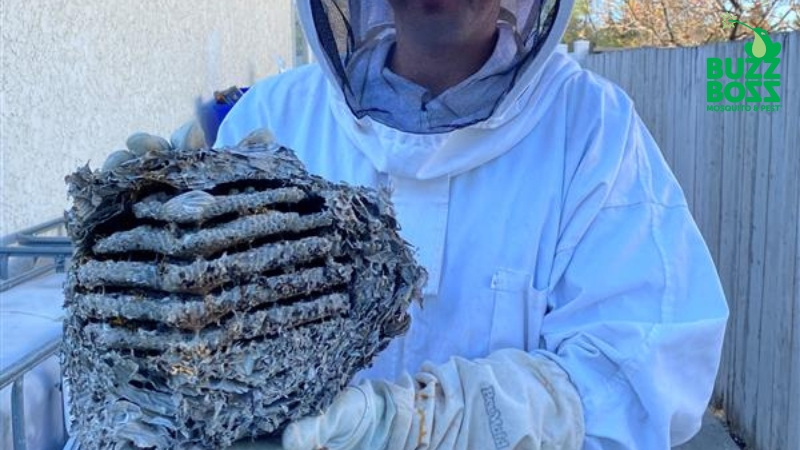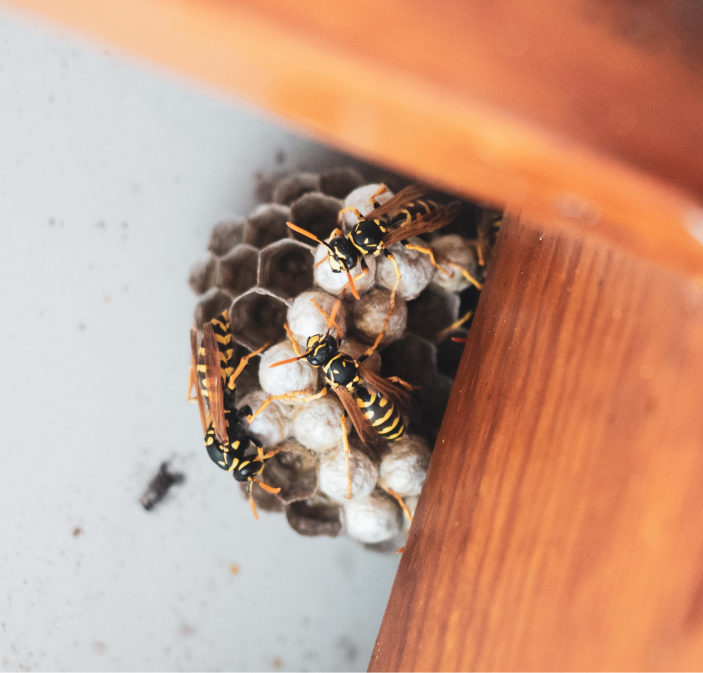What to Do When You Find Wasps in Your Yard
Reading time: 7 minutesAh, summers—a time for sunny skies, backyard barbecues, and, unfortunately, the not-so-welcome buzz of wasps.
These not-so-nice, winged party crashers are infamous for turning your peaceful patio into their summer playground. But don’t let their buzzing and bumbling disrupt your outdoor fun!
Knowing what to do when these angry, often aggressive, guests make an appearance is important, especially considering that an encounter is almost unavoidable.
So next time you see them buzzing around your yard or making a nest under your eaves, remember, staying calm and prepared is your best defence.

You Found Wasps in Your Yard—A Step By Step Guide To Handling the Situation
So, now that you’ve confirmed the presence of wasps in your yard, you want to take immediate and proactive steps to manage their presence effectively and safely.
Step 1: Don’t Panic
If a wasp is approaching but not attacking, remain calm and still. Sudden movements can provoke wasps, increasing the likelihood of you being stung. Move slowly away from the area if the wasps persist. Keep your movements deliberate and controlled.
If you're swarmed or under direct attack, especially if a nest is disturbed, run away as fast as you can. Find the nearest shelter, such as a building or vehicle. Avoid flailing or swatting at the wasps, as this can increase their aggressiveness. Don’t jump into the water. Wasps will not let up their attack. And always remember to protect your face and eyes as you escape.
Step 2: Identify the Wasps
The most common visitors, Yellowjackets and Paper Wasps are easily identifiable.
Yellowjackets have a signature bright yellow and black striping, while Paper Wasps are longer, thinner, and typically a brownish colour. Both types are drawn to open food sources and can often be seen hovering around protein-rich foods and sweet drinks.
Step 3: Locate the Nest from a Safe Distance
Safety should always be your top priority when dealing with wasps. So when you’re trying to find the hotspot, maintain a safe distance. Move slowly and deliberately to avoid startling the wasps, which could provoke an attack. Wear protective clothing, including long sleeves, pants, and gloves. This protective gear can help prevent stings if wasps become aggressive.
Typical nesting sites include in the ground, in trees, under roof eaves, behind shutters, or within dense shrubbery. Wasps prefer these spots since they offer protection from external elements and human traffic.

Step 4: Determine the Size of the Infestation
Is the nest small and newly formed? Or is it large?
Carefully approach the nest to get a closer look (maintaining a safe distance). The size of the nest can often indicate the size of the colony:
- Small Nest: Typically the size of a golf ball to a baseball. Usually houses a small number of wasps (10-50).
- Medium Nest: About the size of a basketball. Possibly contains hundreds of wasps.
- Large Nest: Larger than a basketball. It can house thousands of wasps.
If you see a wasp nest, here’s what you do next…
Step 5: Educate Your Household
Make sure all family members, including children, understand the importance of not disturbing wasps or their nests. Teach them how to react safely if they encounter a wasp to avoid provoking an attack, such as calmly walking away rather than swatting at the wasp.

Step 6: Call Professional Wasp Control
If you find an active nest or you’re dealing with a large number of wasps, it’s best to call in professional pest control services like Buzz Boss. Our BuzzAttack™ Wasp service works quickly to remove wasp nests from your yard. We start by assessing the situation, after which our team comes in to perform the removal. Not only that, we provide advice on preventing future infestations, thereby ensuring your yard remains wasp-free.
Step 7: Integrate Physical Barriers
Your wasp exterminator might recommend a course of action. Incorporating physical barriers such as wasp traps and nets can significantly enhance your defence against wasps. Wasp traps work by luring wasps into a container from which they cannot escape, gradually reducing the population in your yard. These traps can be particularly effective when placed strategically around the perimeter of your outdoor space or near known wasp hotspots.

Step 8: Implement Preventative Treatments
Prevention is always better than the cure. A comprehensive pest control service like our BuzzShield® Complete provides year-round protection, creating conditions that deter wasps and other pests. Regular treatments keep wasps at bay, preventing them from establishing a foothold in your yard.
What To Do After Your Wasp Pest Control Service Leaves?
The nest is gone, so your backyard is now safe. You no longer have to worry about being attacked while you mow your lawn. So what’s next? Here’s what you can do to add that extra layer of protection to keep wasps away:
- Use Temporary Deterrents. There are several temporary measures you can employ to discourage wasps from nesting in your yard. One effective method is to install decoy nests. Wasps are territorial creatures and generally won't build a nest within 20 feet of another one. Place decoy nests around your yard to create no-go zones for new colonies. Additionally, you can use natural repellents, such as sprays made from peppermint oil or vinegar, to deter wasps. These substances are unpleasant to wasps but won't harm them or your plants.
- Repellents and Insecticides. While natural solutions are preferable, sometimes environment-friendly chemical repellents and insecticides are necessary for immediate relief from wasps, especially in severe infestations. Use insecticides specifically designed for wasps and always follow the manufacturer's instructions to ensure safety and effectiveness.
- Manage Standing Water. Remove sources of stagnant water in your yard. Wasps are attracted to all kinds of water bodies as that’s their source of food and energy. Keep birdbaths clean and consider installing a water feature with running water which is less attractive to wasps. Regularly changing the water in birdbaths and other containers will discourage wasps from gathering and breeding in these areas.
- Keep Garbage Covered. Reducing factors that attract wasps is crucial in managing their presence. Ensure that all garbage bins in your yard are tightly sealed to prevent wasps from accessing food remnants. Clean up immediately after outdoor meals to avoid leaving residues that attract wasps. Also, cover compost piles and ensure that any pet food is stored in sealed containers.
- Maintain Your Yard. Regularly maintaining your yard can significantly reduce the likelihood of wasps setting up residence. Trim bushes and trees regularly to eliminate potential nesting sites. Remove garden debris and old furniture where wasps could build hidden nests. Pay particular attention to sheltered, undisturbed corners of your garden, which are attractive spots for wasps to colonize.
- Cultivate a Wasp-Repellent Garden. Planting wasp-repellent plants such as spearmint, thyme, and eucalyptus can help keep wasps away. Their strong scents are unappealing to wasps. Consider installing fans in outdoor living areas, as the wind from the fans disrupts wasps’ flight patterns, making your dining area less appealing to them.
- Promote Natural Wasp Predators. Enhance the presence of natural wasp predators in your yard by installing bird feeders and bird baths. These features attract birds that prey on wasps and their larvae, effectively controlling the wasp population. Encouraging such biodiversity not only helps in pest control but also supports local wildlife. Additionally, consider planting native shrubs and trees that provide shelter for predatory birds, further establishing a natural defence against wasps.

I Got Stung by A Wasp! What Do I Do?
If you or a family member is stung by a wasp, first remove any stinger embedded in the skin. Clean the area thoroughly with soap and water to prevent infection. Apply ice packs or baking soda to reduce swelling and alleviate pain. Elevate the area if possible. Over-the-counter antihistamines and pain relievers can also help manage symptoms. Seek medical attention if the sting site worsens over several days or you experience other symptoms like fever or flu.
Say Goodbye to Wasps with Buzz Boss
As you gear up for a wasp-free summer, remember that staying proactive is key to avoiding a showdown with these pests. However, if you do find yourself in a situation where wasps have made their way into your yard – don’t try and handle it yourself. It can be risky.
Instead, rely on professional wasp nest removal services to safely and effectively handle the problem. Don’t let wasps put a damper on your outdoor fun, contact our experts today and enjoy a peaceful, wasp-free environment all summer long.
If you’re facing wasp problems in any of these cities—Red Deer, Calgary, Edmonton, Regina, Saskatoon, Winnipeg, and Okanagan—Buzz Boss is here to help.

BuzzAttack™
Emergency Service
Wasp nests can ruin any beautiful outdoor area. If your yard is affected by a nest, our team will get there fast, solve the problem, and ensure they don’t come back.
Get an Estimate
